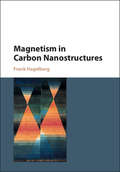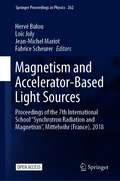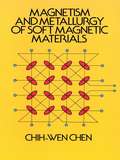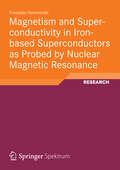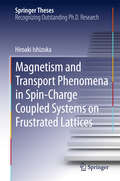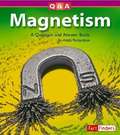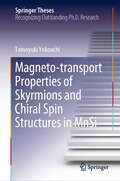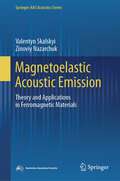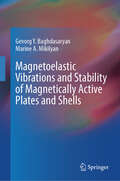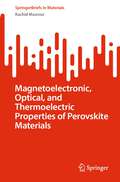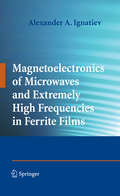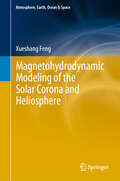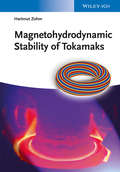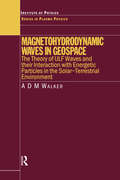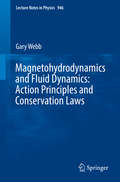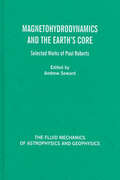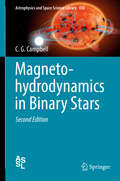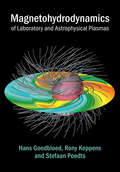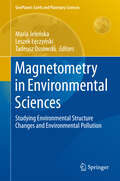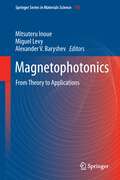- Table View
- List View
Magnetism In Carbon Nanostructures
by Frank HagelbergMagnetism in carbon nanostructures is a rapidly expanding field of current materials science. Its progress is driven by the wide range of applications for magnetic carbon nanosystems, including transmission elements in spintronics, building blocks of cutting-edge nanobiotechnology, and qubits in quantum computing. These systems also provide novel paradigms for basic phenomena of quantum physics, and are thus of great interest for fundamental research. This comprehensive survey emphasizes both the fundamental nature of the field, and its groundbreaking nanotechnological applications, providing a one-stop reference for both the principles and the practice of this emerging area. With equal relevance to physics, chemistry, engineering and materials science, senior undergraduate and graduate students in any of these subjects, as well as all those interested in novel nanomaterials, will gain an in-depth understanding of the field from this concise and self-contained volume.
Magnetism and Accelerator-Based Light Sources: Proceedings of the 7th International School ‘‘Synchrotron Radiation and Magnetism’’, Mittelwihr (France), 2018 (Springer Proceedings in Physics #262)
by Hervé Bulou Loïc Joly Jean-Michel Mariot Fabrice ScheurerThis open access book collects the contributions of the seventh school on Magnetism and Synchrotron Radiation held in Mittelwihr, France, from 7 to 12 October 2018. It starts with an introduction to the physics of modern X-ray sources followed by a general overview of magnetism. Next, light / matter interaction in the X-ray range is covered with emphasis on different types of angular dependence of X-ray absorption spectroscopy and scattering. In the end, two domains where synchrotron radiation-based techniques led to new insights in condensed matter physics, namely spintronics and superconductivity, are discussed. The book is intended for advanced students and researchers to get acquaintance with the basic knowledge of X-ray light sources and to step into synchrotron-based techniques for magnetic studies in condensed matter physics or chemistry.
Magnetism and Electricity
by The Regents of the University of CaliforniaThese stories allow students to investigate real objects and organisms in the module activities and through these hands-on experiences begin to construct their ideas about the natural world.
Magnetism and Metallurgy of Soft Magnetic Materials
by Chih-Wen ChenSoft magnetic materials are economically and technologically the most important of all magnetic materials. In particular, the development of new materials and novel applications for the computer and telecommunications industries during the past few decades has immensely broadened the scope and altered the nature of soft magnetic materials. In addition to metallic substances, nonmetallic compounds and amorphous thin films are coming increasingly important. This thorough, well-organized volume -- on of the most comprehensive treatments available -- offers a coherent, logical presentation of the physical principles underlying both the intrinsic and applied properties of soft magnetism. Two basic components are stressed: (1) traditional magnetism, which imparts magnetization and spin-dependent properties, and (2) metallurgy, which governs the preparation of the products and the attainment of their structure-sensitive properties. The book comprises seven major chapters: Introduction; Ferromagnetism and Ferrimagnetism; Magnetization and Domain Structure; Magnetic Properties; Metallurgy of Soft Magnetic Materials; Applications of Soft Magnetic Materials; and Special Topics (radiation effects and magnetic bubbles and devices). In addition to an extensive introduction to the basic principles of magnetism relevant to all magnetic materials (Chapters I-IV), Professor Chen (Lawrence Livermore National Laboratory) devotes the core of the book to a rigorous, detailed discussion of the effects of metallurgical factors such as purity, alloying, grain structure, defects, and atomic order on the properties and performance of magnetic metals, alloys, and compounds. An extensive and important chapter on the special topics of magnetic bubbles and radiation effects rounds out this timely and wide-ranging survey of a crucial topic in solid state physics. Written for materials scientists, experimental physicists, and metallurgists, the book also lends itself to use as a textbook for graduate courses in magnetic materials.
Magnetism and Superconductivity in Iron-based Superconductors as Probed by Nuclear Magnetic Resonance
by Franziska HammerathNuclear Magnetic Resonance (NMR) has been a fundamental player in the studies of superconducting materials for many decades. This local probe technique allows for the study of the static electronic properties as well as of the low energy excitations of the electrons in the normal and the superconducting state. On that account it has also been widely applied to Fe-based superconductors from the very beginning of their discovery in February 2008. This dissertation comprises some of these very first NMR results, reflecting the unconventional nature of superconductivity and its strong link to magnetism in the investigated compounds LaO1-xFxFeAs and LiFeAs.
Magnetism and Transport Phenomena in Spin-Charge Coupled Systems on Frustrated Lattices
by Hiroaki IshizukaIn this thesis, magnetism and transport phenomena in spin-charge coupled systems on frustrated lattices are theoretically investigated, focusing on Ising-spin Kondo lattice models and using a combination of Monte Carlo simulation and other techniques such as variational calculations and perturbation theory. The emphasis of the study is on how the cooperation of spin-charge coupling and geometrical frustration affects the thermodynamic properties of the Kondo lattice models; it presents the emergence of various novel magnetic states, such as the partial disorder, loop-liquid, and spin-cluster states. The thesis also reveals that the magnetic and electronic states and transport properties of these models demonstrate peculiar features, such as Dirac half-metals, anomalous Hall insulators, and spin Hall effects. Study of novel magnetic states and exotic transport phenomena in Kondo lattice systems is a field experiencing rapid progress. The interplay of charge and spin degrees of freedom potentially gives rise to various novel phases and transport phenomena which are related to strongly correlated electrons, frustrated magnetism, and topological states of matter. The results presented in this thesis include numerical calculations that are free from approximations. Accordingly, they provide reliable reference values, both for studying magnetism and transports of related models and for experimentally exploring novel states of matter in metallic magnets.
Magnetism: A Question and Answer Book
by Adele RichardsonIntroduces magnetism and the creation, forces, and applications of magnets.
Magneto Luminous Chemical Vapor Deposition (Green Chemistry and Chemical Engineering)
by Hirotsugu YasudaThe magneto luminous chemical vapor deposition (MLCVD) method is the perfect example of the "front-end green process." It employs an entirely new process that expends the minimum amount of materials in gas phase, yields virtually no effluent, and therefore requires no environmental remediation. Unlike the "back-end green process," which calls for a
Magneto-transport Properties of Skyrmions and Chiral Spin Structures in MnSi (Springer Theses)
by Tomoyuki YokouchiThis book provides extensive and novel insights into transport phenomena in MnSi, paving the way for applying the topology and chirality of spin textures to the development of spintronics devices. In particular, it describes in detail the key measurements, e.g. magnetoresistance and nonlinear electronic transport, and multiple material-fabrication techniques based on molecular beam epitaxy, ion-beam microfabrication and micromagnetic simulation. The book also reviews key aspects of B20-type MnSi chiral magnets, which host magnetic skyrmions, nanoscale objects formed by helical spatial spin structures. Readers are then introduced to cutting-edge findings on the material. Furthermore, by reviewing the author’s successful experiments, the book provides readers with a valuable update on the latest achievements in the measurement and fabrication of magnetic materials in spintronics.
Magnetoconvection
by N. O. Weiss M. R. E. ProctorThe last thirty years have seen great leaps forward in the subject of magnetoconvection. Computational techniques can now explain exotic nonlinear behaviour, transition to chaos and the formation of structures that can be observed on the surface of the Sun. Here, two leading experts present the current state of knowledge of the subject. They provide a mathematical and numerical treatment of the interactions between electrically conducting fluids and magnetic fields that lead to the complex structures and rich behaviour observed on the Sun and other stars, as well as in the interiors of planets like the Earth. The authors' combined analytical and computational approach provides a model for the study of a wide range of related problems. The discussion includes bifurcation theory, chaotic behaviour, pattern formation in two and three dimensions, and applications to geomagnetism and to the properties of sunspots and other features at the solar surface.
Magnetoelastic Acoustic Emission: Theory and Applications in Ferromagnetic Materials (Springer-AAS Acoustics Series)
by Zinoviy Nazarchuk Valentyn SkalskyiThe book presents theoretical and experimental studies to establish the relationship between volume jumps of the 90° domain wall in a ferromagnetic material and the magnitude of the half-space surface displacement caused by it. A method of evaluating the influence of the external magnetic field on the stress intensity factor at the tip of the crack-like defects in ferromagnets is discussed. The influence of hydrogen on the generation of magneto-elastic acoustic emission signals of ferromagnets is described. The features of magneto-elastic acoustic emission due to the presence of plastic deformation, structural changes, and volumetric damage in such structural materials are shown.
Magnetoelastic Vibrations and Stability of Magnetically Active Plates and Shells
by Gevorg Y. Baghdasaryan Marine A. MikilyanThis book introduces the reader to methods of mathematical modeling and solving non-stationary (dynamic) problems of the theory of magnetoelasticity, as well as to give an idea of the wealth of physical effects caused by the interaction of electromagnetic and mechanical phenomena in magnetically active elastic thin bodies. The studies are mainly limited to a model of isotropic body under the assumption of small deformations. In the first chapter of the book, based on the basic connected nonlinear equations and relations of mechanics and quasi-static electrodynamics of continuum media, a system of equations of magnetoelasticity, surface conditions, and governing equations describing the behavior of disturbances in a magnetoactive medium interacting with an external magnetic field is obtained. On this basis, in Chapters 2 and 3, using the main equations and relations of magnetoelastic vibrations and stability of magnetically soft, thin plates and shells are obtained. By solving specific applied problems, a number of qualitative and quantitative results were identified, caused by the interaction of mechanical and magnetic phenomena in ferromagnetic thin bodies. An approximate formula is obtained to determine magnetohydrodynamic pressure on the oscillating surfaces of plate flowing by supersonic flow of perfectly conducting gas in the presence of magnetic field. This formula is the generalization of well-known formula obtained on the basis of the classical piston theory of gas dynamics in the case of magneto-gas-dynamic flow. On this basis, it became possible to solve complex problems of aeromagnetoelasticity. In the 4th and 5th chapters magnetoelastic processes in superconducting thin shells located in stationary and non-stationary magnetic fields are studied. Two-dimensional equations and corresponding conditions are obtained, which characterize vibrations and stability of superconducting cylindrical and spherical shells under the influence of the given magnetic field. By solving specific problems, the possibility of loss of both static and dynamic stability of thin superconducting bodies under the influence of external magnetic field has been established. The sixth chapter is devoted to mathematical modeling and investigation of issues of dynamics of magnetostrictive plates in magnetic fields (stationary and non-stationary) of several orientations. To study the processes of magnetoelastic interaction in the plate under consideration with complex physical properties of its material, the main postulates of the classical theories and methods were used. The influence of plate in-homogeneity on the processes under consideration was also studied. Dynamic processes in layered plates have been studied. It is shown that heterogeneity is sufficient to control optimally the studied dynamic processes, especially those that arise as a result of interaction. The last 7th chapter is devoted to the investigation of stability of dielectric thin plates in a supersonic flow of perfectly conducting gas in the presence of magnetic field. The problems were studied in both linear and nonlinear formulations. Based on the formula obtained by the authors specific problems of stability were solved. Influence of magnetic field on the flutter characteristics is studied.
Magnetoelectronic, Optical, and Thermoelectric Properties of Perovskite Materials (SpringerBriefs in Materials)
by Rachid MasrourThis book undertakes an extensive exploration of manganese-based compounds, such as T₁₋ₓSrxMnO₃ (T = La, Pr; x = 0.35, 0.25) using density functional theory and Monte Carlo simulations with a focus on understanding their electronic, magnetic, and magnetocaloric properties. Ba₁₋ₓSrxFeO₃ (x = 0, 0.2) is also studied via different approximations, offering a comparative perspective. In addition, the book looks at the influence of magnetism using Monte Carlo simulations, revealing crucial parameters and examining the GdCrO₃ system through DFT and Monte Carlo simulation, shedding light on recent experimental observations. Additionally, Monte Carlo studies investigate magnetic and magnetocaloric features of Sr₂FeMoO₆, La₂SrMn₂O₇ bilayer manganite, perovskite ferromagnetic thin films' surface effects, and SmFe₁₋ₓMnxO₃ perovskite. In essence, this book significantly advances our comprehension of magnetic and magnetocaloric phenomena across diverse materials and is well-suited for both experimentalists and computational researchers working in this field.
Magnetoelectronics of Microwaves and Extremely High Frequencies in Ferrite Films
by Alexander A. IgnatievThis book is devoted to an entirely new direction of the magnetoelectronics of millimetric waves in layered structures containing epitaxial ferrite films. The new electrodynamic approach for research of electromagnetic waves in layered bigyrotropic structures- excitation of waves in converters with parallel and orthogonal orientations- is evaluated. In addition, the results of experimental research are mentioned and new methods of not destroying diagnostics of ferrite films magnetic parameters are considered. The discrepancy of resonant frequencies and the magnetic fields corresponding to them, determined from magnetoscopia and electrodynamic theories, is shown. Results of research on parameters of passive devices on milliwatt and kilowatt levels of capacity on millimetric are also explained in this text.
Magnetohydrodynamic Modeling of the Solar Corona and Heliosphere (Atmosphere, Earth, Ocean & Space)
by Xueshang FengThe book covers intimately all the topics necessary for the development of a robust magnetohydrodynamic (MHD) code within the framework of the cell-centered finite volume method (FVM) and its applications in space weather study. First, it presents a brief review of existing MHD models in studying solar corona and the heliosphere. Then it introduces the cell-centered FVM in three-dimensional computational domain. Finally, the book presents some applications of FVM to the MHD codes on spherical coordinates in various research fields of space weather, focusing on the development of the 3D Solar-InterPlanetary space-time Conservation Element and Solution Element (SIP-CESE) MHD model and its applications to space weather studies in various aspects. The book is written for senior undergraduates, graduate students, lecturers, engineers and researchers in solar-terrestrial physics, space weather theory, modeling, and prediction, computational fluid dynamics, and MHD simulations. It helps readers to fully understand and implement a robust and versatile MHD code based on the cell-centered FVM.
Magnetohydrodynamic Stability of Tokamaks
by Hartmut ZohmThis book bridges the gap between general plasma physics lectures and the real world problems in MHD stability. In order to support the understanding of concepts and their implication, it refers to real world problems such as toroidal mode coupling or nonlinear evolution in a conceptual and phenomenological approach. Detailed mathematical treatment will involve classical linear stability analysis and an outline of more recent concepts such as the ballooning formalism. The book is based on lectures that the author has given to Master and PhD students in Fusion Plasma Physics. Due its strong link to experimental results in MHD instabilities, the book is also of use to senior researchers in the field, i.e. experimental physicists and engineers in fusion reactor science.The volume is organized in three parts. It starts with an introduction to the MHD equations, a section on toroidal equilibrium (tokamak and stellarator), and on linear stability analysis. Starting from there, the ideal MHD stability of the tokamak configuration will be treated in the second part which is subdivided into current driven and pressure driven MHD. This includes many examples with reference to experimental results for important MHD instabilities such as kinks and their transformation to RWMs, infernal modes, peeling modes, ballooning modes and their relation to ELMs. Finally the coverage is completed by a chapter on resistive stability explaining reconnection and island formation. Again, examples from recent tokamak MHD such as sawteeth, CTMs, NTMs and their relation to disruptions are extensively discussed.
Magnetohydrodynamic Waves in Geospace: The Theory of ULF Waves and their Interaction with Energetic Particles in the Solar-Terrestrial Environment (Series in Plasma Physics)
by A.D.M. WalkerSolar-terrestrial physics deals with phenomena in the region of space between the surface of the Sun and the upper atmosphere of the Earth, a region dominated by matter in a plasma state. This area of physics describes processes that generate the solar wind, the physics of geospace and the Earth's magnetosphere, and the interaction of magnetospheri
Magnetohydrodynamics and Fluid Dynamics: Action Principles and Conservation Laws
by Gary WebbThis text focuses on conservation laws in magnetohydrodynamics, gasdynamics and hydrodynamics. A grasp of new conservation laws is essential in fusion and space plasmas, as well as in geophysical fluid dynamics; they can be used to test numerical codes, or to reveal new aspects of the underlying physics, e.g., by identifying the time history of the fluid elements as an important key to understanding fluid vorticity or in investigating the stability of steady flows. The ten Galilean Lie point symmetries of the fundamental action discussed in this book give rise to the conservation of energy, momentum, angular momentum and center of mass conservation laws via Noether’s first theorem. The advected invariants are related to fluid relabeling symmetries – so-called diffeomorphisms associated with the Lagrangian map – and are obtained by applying the Euler-Poincare approach to Noether’s second theorem. The book discusses several variants of helicity including kinetic helicity, cross helicity, magnetic helicity, Ertels’ theorem and potential vorticity, the Hollman invariant, and the Godbillon Vey invariant. The book develops the non-canonical Hamiltonian approach to MHD using the non-canonical Poisson bracket, while also refining the multisymplectic approach to ideal MHD and obtaining novel nonlocal conservation laws. It also briefly discusses Anco and Bluman’s direct method for deriving conservation laws. A range of examples is used to illustrate topological invariants in MHD and fluid dynamics, including the Hopf invariant, the Calugareanu invariant, the Taylor magnetic helicity reconnection hypothesis for magnetic fields in highly conducting plasmas, and the magnetic helicity of Alfvén simple waves, MHD topological solitons, and the Parker Archimedean spiral magnetic field. The Lagrangian map is used to obtain a class of solutions for incompressible MHD. The Aharonov-Bohm interpretation of magnetic helicity and cross helicity is discussed. In closing, examples of magnetosonic N-waves are used to illustrate the role of the wave number and group velocity concepts for MHD waves. This self-contained and pedagogical guide to the fundamentals will benefit postgraduate-level newcomers and seasoned researchers alike.
Magnetohydrodynamics and the Earth's Core: Selected Works by Paul Roberts (The Fluid Mechanics of Astrophysics and Geophysics)
by Andrew SowardPaul Roberts' research contributions are remarkable in their diversity, depth and international appeal. Papers from the Paul Roberts' Anniversary meeting at the University of Exeter are presented in this volume. Topics include geomagnetism and dynamos, fluid mechanics and MHD, superfluidity, mixed phase regions, mean field electrodynamics and the E
Magnetohydrodynamics in Binary Stars (Astrophysics and Space Science Library #456)
by C. G. CampbellMagnetism in binary stars is an area of central importance in stellar astrophysics. The second edition of "Magnetohydrodynamics in Binary Stars" is a major revision of the first edition. The material has been updated and extended, including additional chapters on the origins of the stellar magnetic fields and accretion disc magnetic winds. A comprehensive account is given of the subject, from the early work up to the latest results. The unifying theme remains the redistribution of angular momentum by magnetic stresses. This occurs in a wide variety of ways, including magnetic stellar and orbital coupling, magnetic channelling of accretion streams, magnetic stellar coupling to accretion discs, dynamo field coupling in discs, and magnetic stellar and disc winds. The associated stellar spin and orbital evolution problems, including stability, are also considered. Although the main focus is on binary stars, much of the work on accretion discs and wind flows has more general astrophysical relevance. Convenient formulae are included that can be compared to observations, making the book useful to observers as well as theorists, and there are extensive reference lists. The material is mainly aimed at research workers, but parts of the text could be useful for postgraduate courses in magnetic stellar astrophysics topics.
Magnetohydrodynamics of Laboratory and Astrophysical Plasmas: With Applications To Laboratory And Astrophysical Plasmas
by Rony Keppens Stefaan Poedts Hans GoedbloedWith ninety per cent of visible matter in the universe existing in the plasma state, an understanding of magnetohydrodynamics is essential for anyone looking to understand solar and astrophysical processes, from stars to accretion discs and galaxies; as well as laboratory applications focused on harnessing controlled fusion energy. This introduction to magnetohydrodynamics brings together the theory of plasma behavior with advanced topics including the applications of plasma physics to thermonuclear fusion and plasma- astrophysics. Topics covered include streaming and toroidal plasmas, nonlinear dynamics, modern computational techniques, incompressible plasma turbulence and extreme transonic and relativistic plasma flows. The numerical techniques needed to apply magnetohydrodynamics are explained, allowing the reader to move from theory to application and exploit the latest algorithmic advances. Bringing together two previous volumes: Principles of Magnetohydrodynamics and Advanced Magnetohydrodynamics, and completely updated with new examples, insights and applications, this volume constitutes a comprehensive reference for students and researchers interested in plasma physics, astrophysics and thermonuclear fusion.
Magnetohydrodynamics of the Sun
by Eric PriestMagnetohydrodynamics of the Sun is a completely new up-to-date rewrite from scratch of the 1982 book Solar Magnetohydrodynamics, taking account of enormous advances in understanding since that date. It describes the subtle and complex interaction between the Sun's plasma atmosphere and its magnetic field, which is responsible for many fascinating dynamic phenomena. Chapters cover the generation of the Sun's magnetic field by dynamo action, magnetoconvection and the nature of photospheric flux tubes such as sunspots, the heating of the outer atmosphere by waves or reconnection, the structure of prominences, the nature of eruptive instability and magnetic reconnection in solar flares and coronal mass ejections, and the acceleration of the solar wind by reconnection or wave-turbulence. It is essential reading for graduate students and researchers in solar physics and related fields of astronomy, plasma physics and fluid dynamics. Problem sets and other resources are available at www. cambridge. org/9780521854719.
Magnetometry in Environmental Sciences: Studying Environmental Structure Changes and Environmental Pollution (GeoPlanet: Earth and Planetary Sciences)
by Maria Jeleńska, Leszek Łęczyński and Tadeusz OssowskiThe book offers a review of the work of the Polish Research Group on selected topics of environmental magnetism: the application of magnetic methods to study pollution of outdoor and indoor air, street dust, polluted soil, air filters and indoor dust; the use of magnetic properties to study pedogenic processes in soils and soil structure; as well as deposition processes in recent sediments. The authors focus on detailed cases and provide in-depth explanations of the causes of and relations between physical processes. The examples of different studies demonstrate how to apply magnetometry to solve problems in related disciplines, how to better understand the complexity of the magnetic structure of substances and mediums as well as how to trace interactions between the environment and natural and anthropogenic factors.
Magnetomicrofluidic Circuits for Single-Bioparticle Transport
by Roozbeh Abedini-NassabThis book highlights the current state of the art in magnetophoretic circuits and their use in the emerging field of single-cell analysis. This interdisciplinary topic involves many fields of science including cellular biology, drug screening, cancer research, personalized medicine, microfabrication, biomedical microdevices, and lab-on-a-chip. This book not only provides the required fundamental knowledge and background needed in magnetics and the circuit theory but also describes the idea of magnetophoretic circuits as well as the cutting-edge developed technologies. It provides a sufficient background in i) the required theory in magnetics, ii) SCAs in general, iii) the circuit theory, iv) the developed idea of the magnetophoretic circuits, v) the fabrication process and magnetic cell labeling techniques, vi) the magnetophoretic-based SCA tools, and vii) the bio-applications. Methods for performing simulations as well as designing, fabricating, and running experiments are explained. Author of the book is one of the inventors of some of the ideas and the author/co-author of some of the related articles in high-impact journals. The book appeals to the readers interested in clinical applications as well as the ones interested in its technical aspects. It is beneficial for researchers interested in the field of single-cell analysis from various disciplines including biomedical engineering, mechanical engineering, electrical engineering, materials science, and cellular biology.
Magnetophotonics
by Alexander V. Baryshev Miguel Levy Mitsuteru InoueThis book merges theoretical and experimental works initiated in 1997 from consideration of periodical artificial dielectric structures comprising magneto-optical materials. Modern advances in magnetophotonics are discussed giving theoretical analyses and demonstrations of the consequences of light interaction with non-reciprocal media of various designs. This first collection of foundational works is devoted to light-to-artificial magnetic matter phenomena and related applications. The subject covers the physical background and the continuing research in the field of magnetophotonics.
